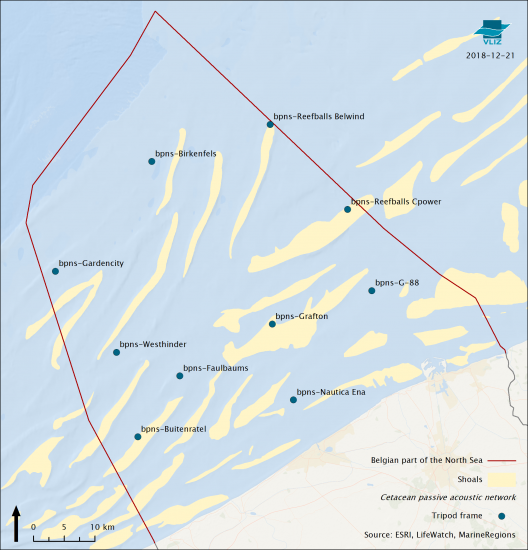Offshore construction activities like impulsive pile driving can affect harbor porpoise and other cetaceans up to large distances from the noise source. At national level, seasonal restrictions related to pile driving are in place in order to protect marine mammals against negative impact.
As part of the LifeWatch marine observatory, a permanent cetacean passive acoustic network has been installed in the Belgian part of the North Sea (BPNS) in order to get a better understanding of the spatio-temporal distributions of harbor porpoises (Phocoena phocoena) and dolphins. This sensor network of passive acoustic hydrophones (C-PODs) records the echolocation clicks produced by these species, providing information on presence and activity throughout the year.
LifeWatch Data Explorer
Cetacean data can be accessed using the LifeWatch Data Explorer. This portal allows you to explore and create various data products. All parameters (duration of clicks, recognized clicks, minutes recording...) available are described on the start page.
- Parameters can be plotted on the map of the BPNS
- A data table including all parameters can be accessed
- Time plots can be created for the different parameters
- Plots can be created for selected variables
Prepared datasets
Customized data frames can be created and stored on the LifeWatch VSC cloud for further exploration, later reference or more extensive calculations. Below, a pre-defined dataset, time series and plots with the following parameters can be accessed:
- Processing: Validated
- Timeframe: 01/08/2018 - 01/08/2020
- Quality: Hi+Mod
- Sample period: 1 week
Data analysis products
A number of pre-calculated maps and graphs visualize the spatio-temporal distribution of harbour porpoises in the BPNS. Example R scripts demonstrate how these products can be created from the data.
- Data preparation & exploration
- Mapping (Output 1 Click frequencies)
- Time series (Output 2 Porpoise presence)
- R scripts to analyze the cetacean data can be found on Github
